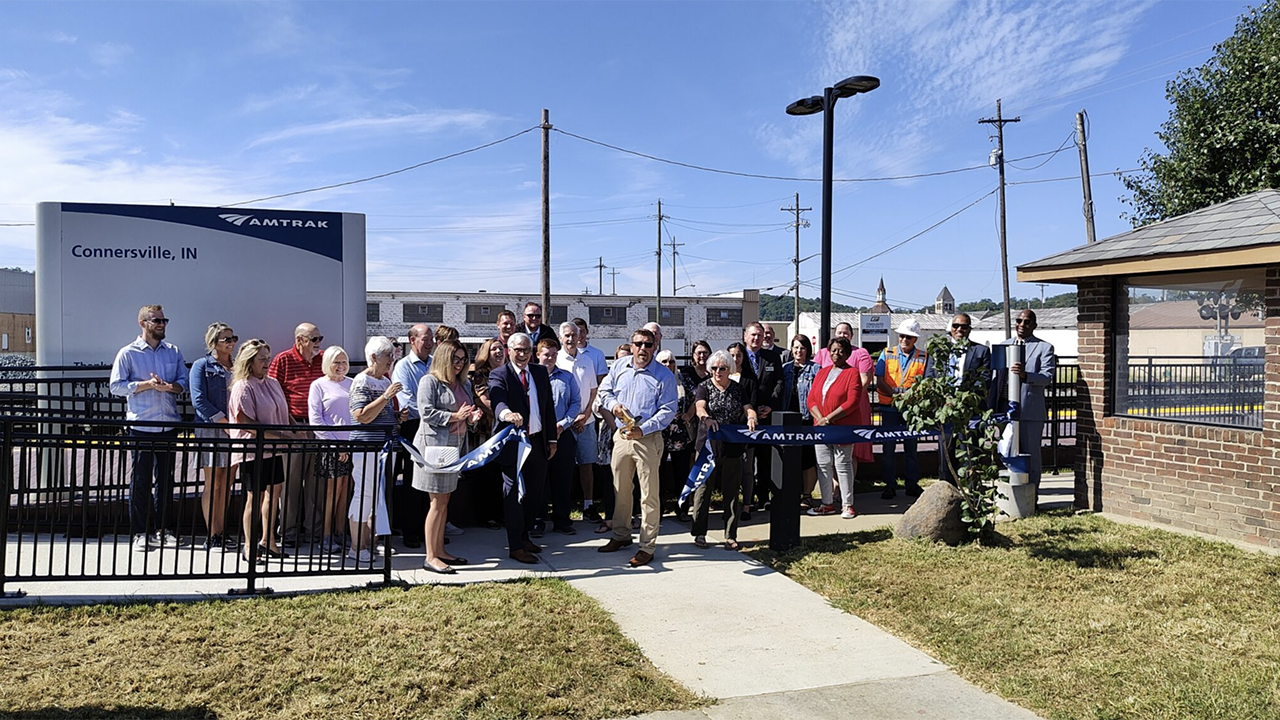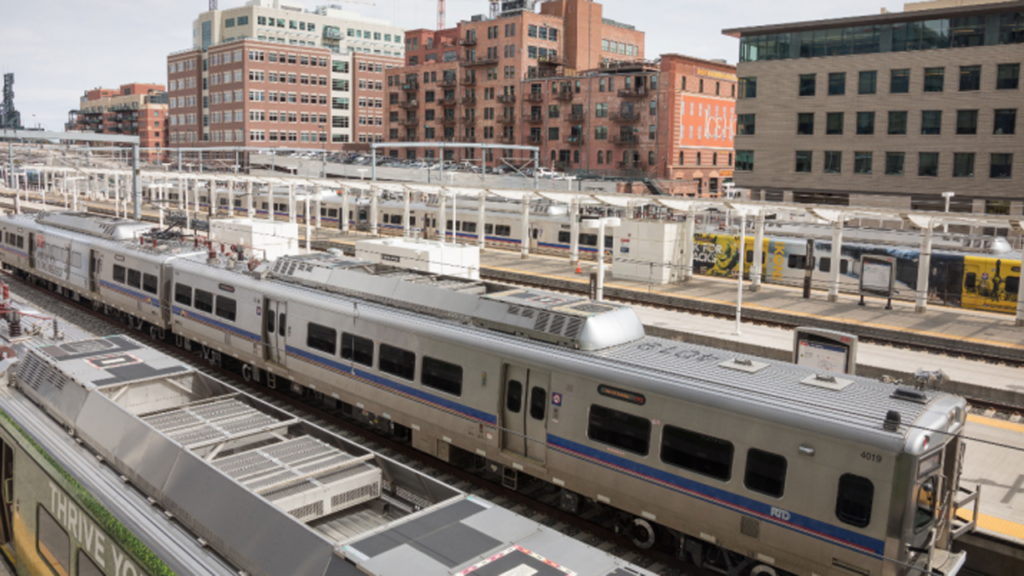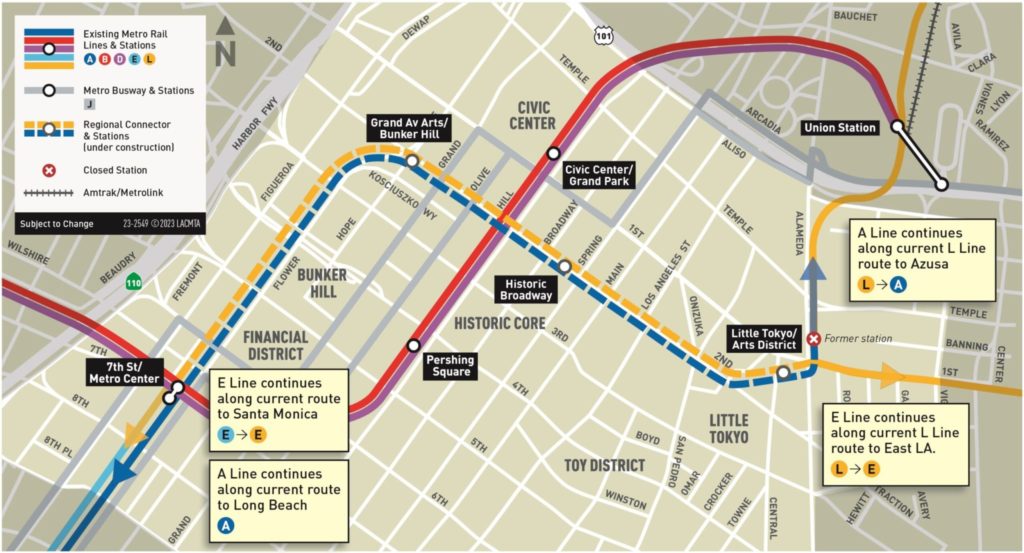
Transit Briefs: Amtrak, Denver RTD, LACMTA
Written by Marybeth Luczak, Executive Editor
Amtrak and Connersville, Ind., held a ribbon-cutting ceremony to mark the completion of an accessibility upgrade project at the city’s Cardinal-served passenger rail station. (Amtrak Photograph)
Amtrak celebrates the completion of a $1.9 million station project in Connersville, Ind. Also, Denver Regional Transportation District’s (RTD) FasTracks bonds rating is upgraded; and Los Angeles County Metropolitan Transportation Authority’s (LACMTA) new Regional Connector project helps boost July ridership.
Amtrak
Amtrak and Connersville, Ind., on Aug. 29 held a ribbon-cutting ceremony to mark the completion of a station-accessibility upgrade project. The city’s passenger rail station is served by the Cardinal three days per week between New York and Chicago.
Improvements included construction of a new concrete platform that meets Americans with Disabilities Act (ADA) specifications; installation of new lighting, a ramp and a new connection to the public right of way; and updates to the parking lot.
Amtrak has served Connersville since 1990, when members of the local Rotary Club raised funds to erect a brick shelter along the now-improved platform. Nearby is the station built in 1914 by the Cincinnati, Hamilton & Dayton Railroad and now used by CSX. According to “America’s Railroad,” the new platform “harmonizes with the historic station with tint and texture.”
Amtrak reported that it has invested $770 million since 2011 in accessibility upgrades and improvement projects at 118 stations across the national network, with 20 stations brought into ADA compliance last year. Another 20 stations are targeted for completion this fiscal year at a forecasted investment of $125 million, according to Amtrak, which noted that it is advancing 143 station designs and 39 station construction projects as it works toward 100% accessibility project completion by 2029.
“Making our stations accessible to all customers is a priority, and we’re actively performing construction, renovation, repair and upgrade projects at stations across our national network,” Amtrak Vice President David Handera said. “We want Connersville and all of our stations to be a welcoming and comfortable environment to all of our customers.”
“The city of Connersville is overjoyed with the upgrades that have been made here in our community,” Mayor Chad Frank said. “Connersville is seeing growth in our community, and we anticipate that the recent improvements to the station will encourage an increase in travelers.”
In a related development, Amtrak has approved a stop in De Soto, Mo., for its Texas Eagle line.
Denver RTD

Denver (Colo.) RTD on Aug. 28 reported that its FasTracks bonds have been upgraded from AA+ to AAA and given a stable outlook by S&P Global Ratings (previously Standard & Poor’s). The move reflects the company’s view that Denver RTD’s financial condition is strong, according to the transit agency, which provides light rail, commuter rail, bus, on-demand, paratransit, airport, and special-event services.
“In July, the RTD Board of Directors approved staff to refund and refinance FasTracks debt, which strengthens the agency’s standing as supported in a statement made in a news release by S&P Global Ratings on Aug. 10,” according to Denver RTD. “S&P Global Ratings recognized the fiscal decisions the RTD Board and staff have made to stabilize RTD’s financial position as it moved out of the pandemic.”
Denver RTD is scheduled to close on the refinanced FasTracks bonds in September. Download the Invitation to Tender Bonds and Preliminary Official Statement for the expected refunding:
“The AAA rating highlights both the strong financial position and prudent financial management of the agency’s resources,” Denver RTD Chief Financial Officer Doug MacLeod said. “The rating change on the FasTracks bonds also increases the probability that RTD will be able to reduce borrowing costs with any future FasTracks bond refinancing activity.”
In other news, the Denver RTD Board recently approved a new fare structure and equity analysis.
LACMTA

LACMTA on Aug. 28 reported that its July ridership growth was fueled by the $1.8 billion Regional Connector project, which opened June 16 to carry riders from Azusa to Long Beach and from East Los Angeles to Santa Monica on one train.
The transit agency saw a 15% year-over-year increase in ridership in July 2023 compared with July 2022, with more than 23.3 million boardings. This marked the eighth consecutive month of year-over-year ridership growth, it said. LACMTA’s monthly rail and bus ridership is now at 76% of its 2019 pre-pandemic level. Average weekend ridership is now at 88% of pre-pandemic (July 2019) levels and 72% for average weekdays.
According to LACMTA, it had 23,337,404 boardings in July on its rail and bus services. An average of 843,459 rides were taken each weekday, with Saturday boardings averaging 643,234 and Sunday boardings averaging 542,009. Post-pandemic ridership recovery continues to be strongest on the weekends, with average boardings on Saturdays reaching more than 86% of their (July 2019) pre-pandemic level and average boardings on Sundays reaching almost 90% of their (July 2019) pre-pandemic level, according to LACMTA.
The transit agency said July 2023 marked the first full month of operation for the newly reconfigured A and E Lines, thanks to the opening of the Regional Connector project in June. The Regional Connector project consolidated three of LACMTA’s legacy rail lines—A (Blue), E (Expo), and L (Gold)—into two. Now, the A Line serves riders from Azuza to Long Beach, and the E Line serves riders from East Los Angeles to Santa Monica. The project also opened three new stations in downtown Los Angeles.
According to LACMTA, during July 2023, ridership on the A and E lines rose 26% on the weekdays compared with the combined ridership on the A (Blue), E (Expo), and L (Gold) lines in July 2022. Ridership on the weekends in July 2023 rose nearly 42% compared with the combined ridership on the A (Blue), E (Expo), and L (Gold) lines in July 2022.
Ridership also rose on the B Line (Red)/D Line (Purple) subway, where LACMTA said there has been an “increased focus on safety and a sharp decrease in crime.” Ridership here in July 2023 rose 13% on the weekdays and 4% on the weekends vs. July 2022. Average Sunday ridership on the B Line and D Line is now at 99% as compared with July 2019, before the pandemic, according to LACMTA. On Sundays in July 2023, an average of 61,290 trips were taken on the B and D lines, compared with 61,923 in July 2019, before the pandemic.
Additionally, ridership on the C Line rose 13% on the weekdays and 16% on the weekends year-over-year. K Line year-over-year information is not yet available as the line opened in October 2022, LACMTA reported.
Weekend ridership, LACMTA said, was driven in part by the special events it supported, including the Anime Expo (A Line), NoHo Summer Nights (B Line), Riverfest (A Line), Rock the Block (K Line), and a soccer match-up between the LA Galaxy and LAFC at the Rose Bowl (A Line).
In July 2023, LACMTA bus ridership saw a nearly 12% year-over-year increase. Almost 18 million rides were taken, with total bus ridership at 75% of its level in July 2019, before the pandemic.
“We continue to be encouraged that more people are choosing to go Metro [LACMTA] on both bus and rail,” LACMTA CEO Stephanie Wiggins said. “We believe these ridership gains can be directly tied to our proactive efforts to improve the customer experience over the past year, from restoring our pre-pandemic level of bus service to making big improvements related to safety, security, and cleanliness on our rail system.”
Separately, LACMTA recently announced that 1.3 million students are eligible for the GoPass pilot program.



